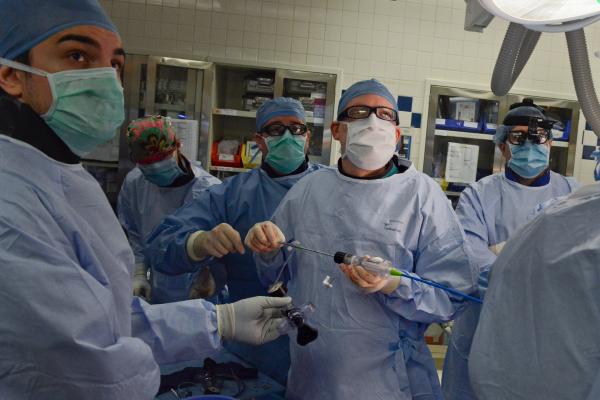
Using the terms plumber, electrician and carpenter are easy ways for most patients to understand when explaining the roles of specialists in complex cardiology procedures. In this image, interventional cardiologist "plumbers" and a cardiac surgeon "carpenter" work as part of the a structural heart team at Henry Ford Hospital while guiding the device using live echo images from the "video guy."
Physicians use many strategies to better interface with patients and their families to try and explain in non-physician terms basic cardiac conditions and how the various subspecialties are involved. My favorite is the analogy of cardiac conditions related to owning an old house and all the issues the homeowner can face, including plumbing issues, electrical issues and structural issues. As an owner of a house built in the 1890s and finding myself doing the majority of the constant repairs, I found these comparisons to be spot on.
When people find out I cover new cardiac technology news, it nearly always sparks a discussion about their cardiovascular condition or that of a family member. However, I find there is little understanding with most people about the differences between and causes of cardiac conditions. When it comes to myocardial infarction, sudden cardiac arrest, angina or arrhythmias that cause a trip to the emergency room, most people just group all these into the generic category of a "heart attack."
I found the old house analogy helpful in making quick, clear distinctions with anyone, regardless of their level of education or understanding of anatomy and physiology.
One of my co-workers came to me the other day to ask questions about the Watchman left atrial appendage (LAA) occluder. Their father-in-law has atrial fibrillation, is on warfarin and was hospitalized for a severe GI bleed, so the care team was looking for an alternative to anticoagulation. When the their heart team introduced themselves to consult with the patient about the Watchman procedure, they introduced the key team members as the "electrician," the "plumber" and the "video guy." They explained the collaboration in patient selection and the procedure between the interventional cardiologist (the plumber) and the electrophysiologist (the electrician). During the procedure, they said they need to rely on the live transesophageal echo (TEE) imaging provided by the echocardiographer (the video guy) to visualize the transeptal puncture and placement of the occluder.
Other friends have called in the past to ask how a transcatheter aortic valve replacement (TAVR) or surgical valve replacement would fix their elderly relative's heart. As with old homes, the building materials degrade over time. Old pipes also can have calcium and rust deposits build up to block pipes or cause valve seats in faucets and showers to leak, requiring them to be replaced. Interventional cardiologists trained in TAVR can act as plumbers to install a new valve to stop the leak, or a surgeon can act as a carpenter to cut out the worn-out materials and replace them.
Other old home analogies related to cardiology might include lessons in prevention (i.e. lifestyle changes). You can't just ignore problems and needed maintenance, or else they become bigger, more expensive problems later. When I first moved into my house, the basement was very damp and had mold. We quickly found the gutters were clogged and water poured over the edges along the sides of the house. The gutter drains also dumped water right along the basement walls, where it just seeped in. A little prevention went a long way to making the basement dry and well again, with annual gutter cleaning and adding gutter extensions to drain the water further into the yard. Painting and repairing the 120-year-old wood siding and window frames, and repairing cracks in the foundation also helps prevent bigger structural issues later.



 December 20, 2023
December 20, 2023 








